#chakrasamvara tantra
Photo

Chakrasamvara and consort Vajravarahi in Yab-Yum pose
32 notes
·
View notes
Photo

Chakrasamvara and Vajravarahi, Kathmandu Valley, Nepal, ca. 1575–1600, distemper on cotton, 71.1 x 61 cm, The Metropolitan Museum of Art.
“The twelve-armed Chakrasamvara embracing his consort, Vajravarahi, is a highly charged vision by an advanced master of tantric Buddhism. Potent color dynamics add tension to the picture. The blue figure of Chakrasamvara has additional heads in yellow, green, and red (symbolizing the colors of the Jina “Victor” Buddhas). With his principal hands he grasps Vajravarahi and holds a bell and a thunderbolt scepter. Chakrasamvara’s iconography closely resembles that of Shiva (both have three eyes and hold a skull cup, trident, and elephant skin); such concordance of Buddhist and Hindu iconography has its origins in the tantrism of medieval eastern India. Here Chakrasamvara and Vajravarahi trample a blue Bhairava and a red Kalartri, showing their dominance over these Hindu gods.”
#buddhist#chakrasamvara and vajravarahi#chakrasamvara#vajravarahi#yab-yum#yabyum#vajrayana#tantra#tantric
39 notes
·
View notes
Text
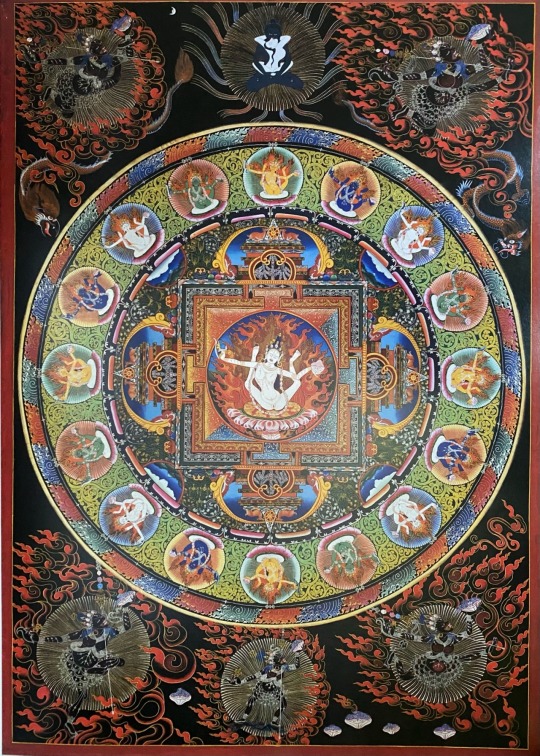
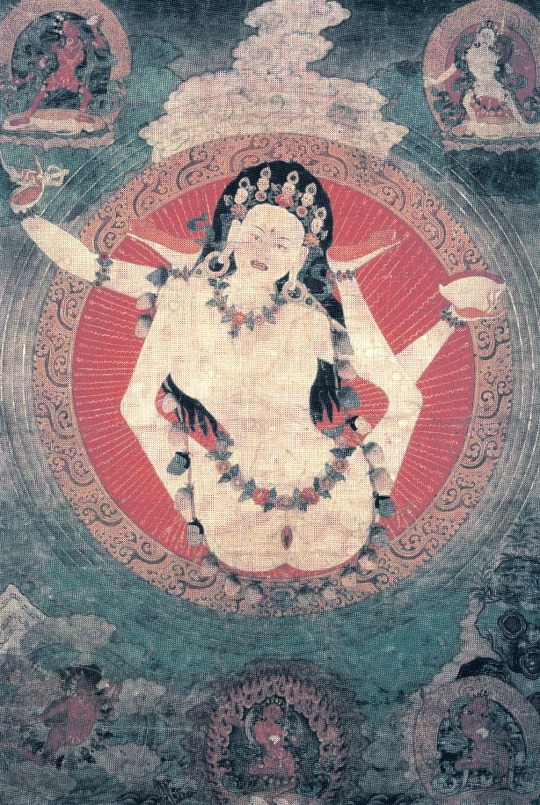

“Dakini Mandala: Gateway to Celestial Bliss” by Romio Shrestha, with text by Ian A. Baker.
From “Celestial Gallery” (2000).
Central image: Sukhasiddhi Dakini
Vajrayogini, is a representation of complete Buddhahood in female form, whose practices are associated with the Chakrasamvara Cycle of Anuttarayoga Tantra.
23 notes
·
View notes
Text

Saṃvara with Vajravārāhī in Yab-Yum pose, the central deity of the tantra.
Chakrasamvara and Vajravarahi. Nepal, Kathmandu Valley, Malla period. The twelve-armed Chakrasamvara embracing his consort, Vajravarahi, is a highly charged vision by an advanced tantric master. Potent color dynamics add tension to the picture. The blue figure of Chakrasamvara has additional heads in yellow, green, and red (symbolizing the colors of the Jina “Victor” Buddhas). With his principal hands he grasps Vajravarahi and holds a bell and a thunder bolt. Chakrasamvara is associated with both Heruka and Hevajra, and his iconography closely resembles that of Shiva (both have three eyes and hold a skull cup, trident, and elephant skin). Such concordance of Buddhist and Hindu iconography has its origins in tantrism of medieval eastern India. Here Chakrasamvara and Vajravarahi trample a blue Bhairava and a red Kalartri, showing their dominance over these Hindu gods.
26 notes
·
View notes
Photo

Chakrasamvara and Consort ca 17th century. Tibet. Mineral pigments with gold on cloth. Chakrasamvara, which translates to "wheel of bliss," is one of the most popular yidam (meditations deity) in Tantric Buddhism after the 11th century. As the principal deities of the Anuttarayoga Tantra of the Vajrayana Buddhist tradition, Chakrasamvara can appear in several dozen different forms, from simple to complex, peaceful to wrathful. Here, Chakrasamvara and his consort Vajravarahi are both shown in wrathful form, standing over Kalaratri and Black Bhairava, symbolizing triumph over ego and ignorance. (via Instagram: Kapoor Galleries)
227 notes
·
View notes
Text

Lion-Faced Ḍākinī
The Tantric Sources
The Lion-Faced Ḍākinī (Tib: Senge Dongma, Skt: Siṃhamukhā) is a female deity considered to be especially effective for dispelling black magic, curses, obstacles and harm-doers. In the Nyingma terma tradition, she is considered as one of the many forms of Padmasambhava, specifically a secret form of Guru Rinpoche manifested to avert spiritual obstacles and negativity. In the Sarma traditions she arises out of the Chakrasamvara cycle of tantras and belongs to the Highest Yoga Tantra ‘wisdom’ classification.
According to Jamyang Khyentse Wangpo, the original scriptural source for Simhamukha is the Drwa-ba’i sdom-pa’i rgyud. This Tantra, where Simhamukha is linked with the eight wrathful Gauris (ke’u-ri-ma brgyad) and the eight Tramenmas or animal-headed sorceresses (phra-men-ma brgyad), appears to be connected with the Guhyagarbha Mayajala cycle (sGyu-‘phrul drwa-ba). In the “Tibetan Book of the Dead” (Bar-do thos grol), these Gauri witches, representing the eight types of mundane consciousness, and these eight animal-headed sorceresses, representing the eight objects of consciousness, appear to the deceased consciousness on the twelfth and thirteenth days of the Bardo experience after death. However, it is mainly through the Termas or hidden treasure texts discovered since the 11th century that Simhamukha is practiced among the Nyingmapas.
According to some sources, it is said that ”at the time of Buddha Amitabha, many aeons even before Shakyamuni Buddha, there was a demon called Garab Wangchuk whose daughter was a lion-faced demoness called Tramen Sengdongma. She delighted in taking the lives of countless beings, and by harming practitioners she increased the negative forces in the world and undermined the Amitabha Buddha’s doctrine.
All the buddhas gathered together and concluded that to tame her they would need to manifest an identical-looking being. The enlightened beings’ collective wisdom arose in the form of a wisdom being – the Lion-faced Dakini, empowered by all the Buddhas of the ten directions with their power and compassion to tame the demoness. The Dakini became far more powerful than the demoness, who then began to lose her strength. While the Dakini was in a deep samadhi of taming the maras, countless dakinis emanated from her and subdued all the demons. Tramen Sengdongma, now pacified, took an oath to serve the dharma and became a protector.
In the time of the 100-year lifespans, Buddha Shakyamuni appeared in the world and turned the wheel of dharma in many places such as Varanasi, Bodhgaya, Vulture’s Peak, and the charnel ground of Lanka, teaching on many levels including Vajrayana. He said that at that time it was as if the sun was in the center of the sky, and there was no darkness anywhere, but when the sun went down then the darkness of ignorance would arise. But Lord Buddha continued that there would be a method to dispel this ignorance, and so Vajrapani requested that Lord Buddha teach this method. Shakyamuni Buddha rested in the samadhi of taming the maras, and then taught the whole cycle of the Lion-Faced Ḍākinī. He taught in many different ways, and these transmissions were concealed by Vajrapani as treasures after he received them.”
Lion-Faced Ḍākinī
The Lion-Faced Ḍākinī is a fully enlightened deity and not a protector spirit or dakini alone. As one source says:
It is important to understand that, despite her exceedingly wrathful appearance and animal head, she is not a guardian spirit (srung-ma), subdued by magic, converted to the Dharma, and bound by oaths of service by some powerful Mahasiddha in the past. Rather, she is a wrathful manifestation of Guhyajnana Dakini, who, according to the Nyingmapa tradition, was the principal Dakini teacher of Padmasambhava in the country of Uddiyana. Therefore, although Simhamukha is a Dakini in her aspect, she functions as a Yidam or meditation deity and her special functions are averting and repulsing (bzlog-pa) psychic attacks that may assault the practitioner and the subduing of negative female energy as personified by the Matrikas or Mamos. These latter are wild uncontrolled female spirits inhabiting the wilderness, both the mountains and the forests, beyond the confines of patriarchal civilization. These female spirits are generally hostile to the male gender. Simhamukha appears in a form wrathful, feminine, and demonic; indeed, her form is said to be actually that of a Matrikia or Mamo, not because her nature is evil or demonic, but because her wrathful aspect (khro gzugs) skillfully overcomes and subdues those violent negative energies. Simhamukha is a Jnana Dakini or wisdom goddess. According to Jigmed Lingpa (1726-1798), the famous Nyingmapa master and discoverer of hidden treasure texts or Termas, Simhamukha represents a Nirmanakaya manifestation, appearing in time and history, whereas her Sambhogakaya aspect is Vajravarahi and her Dharmakaya aspect is Samantabhadri, the Primordial Wisdom herself.
3 notes
·
View notes
Text
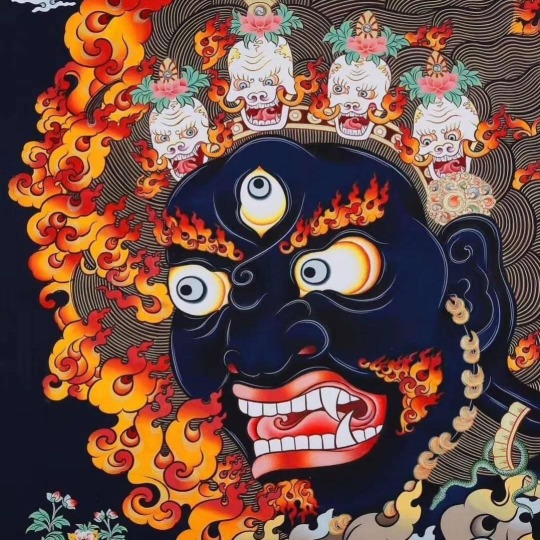
Mahakala (Sanskrit: Mahākāla) is a Dharmapala ("protector of Dharma") in Vajrayana Buddhism (Tibetan, Nepalese Newar, Chinese, Japanese Shingon traditions and related). In Chinese and Japanese Buddhism tradition is known as Daheitian or Daikokuten (大黒天).
Mahakala is a category of Tantric Buddhist deity. His primary function is as a protector (Dharmapala) and specifically the primary Wisdom Protector of Tantric Buddhism - Vajrayana. There are dozens of different variations and forms of Mahakala. He is typically in wrathful appearance following the Indian model of a Raksha demon. In most occurrences and uses of Mahakala, he is paired with a meditational deity such as Panjarnata Mahakala and Shri Hevajra, Chaturbhuja Mahakala and Chakrasamvara, Chaturmukha Mahakala and Guhyasamaja. In most cases Mahakala is an emanation, or wrathful aspect, of the principal meditational deity that he is associated with. For instance Panjarnata Mahakala is the most wrathful emanation, or form, of Hevajra. In other situations Mahakala might be a wrathful emanation of Vajradhara or Akshobhya Buddha. Aside from the individual Anuttarayoga Tantras that teach various forms of Mahakala, the principal texts are the Twenty-five and Fifty Chapter Mahakala Tantra.
In one specific case, Shadbhuja Mahakala, Avalokiteshvara takes on the form of Mahakala. Therefore, it can be said that the Shadbhuja form, with one face and six hands, arising from the Eight Chapter Mahakala Tantra, is a wrathful Avalokiteshvara.
http://en.wikipedia.org/wiki/Mahakala
49 notes
·
View notes
Text
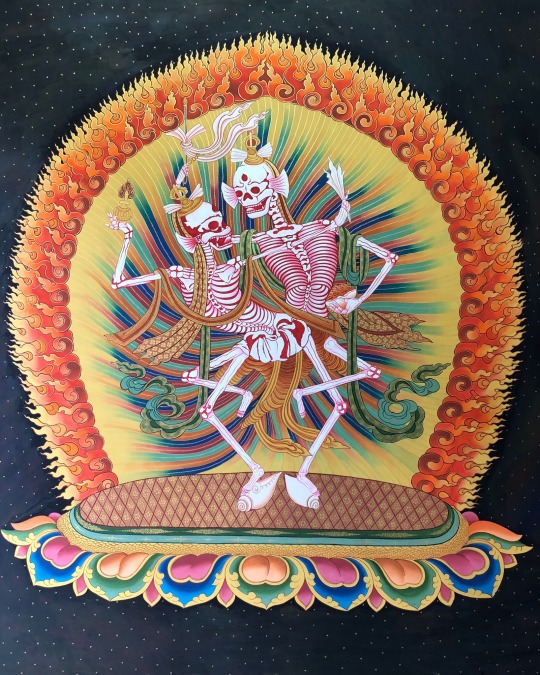
Shri Shmashana Adhipati, as a couple, are enlightened deities categorized as 'Wisdom protectors.' They are emanations of Chakrasamvara and related to the Chakrasamvara and Vajrayogini cycles of tantra.
.
.
.
.
.
#lamathankapaintingschool #buddhism #citipati #tantric #dharma #vajrayogini #vajrayana #himalayan #art #thangka #thankapainting #Adhipati #Shmashana #tiji #festival #lordofcemetery #sacred #heritage #livingheritage #mindfulness #meditation
7 notes
·
View notes
Photo
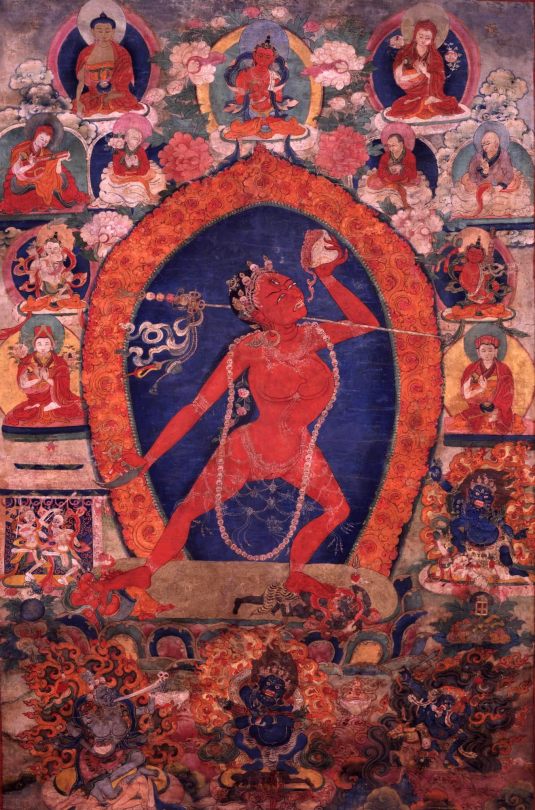
In light of the Supreme Court’s decision to overturn Roe vs Wade, today we're reflecting on the female deities in our collection that are revered in many different traditions throughout the Himalayas. In Tibetan Buddhism, female spiritual deities, known as dakinis, hold immense amounts of power, teaching and guiding practitioners to awakening. In Tibetan Buddhism, Tantric practitioners are required to respect women and female deities in tantra are not only consorts of male deities but have their own identities.
This work depicts the dakini Vajrayogini. In many esoteric Buddhist traditions, Vajrayogini is considered to be the ultimate expression of tantric Buddhahood. Vajrayogini embodies the wisdom of all buddhas. Originally, she was a consort for the Buddhist deity Chakrasamvara, but she eventually developed a cult and practice of her own. She demonstrates that all beings can achieve enlightenment through the tantric path, no matter what gender their body may be.
_______
The Red Yogini; Vajrayogini; Tibet; 19th century; pigments on cloth; Rubin Museum of Art; C2002.24.11 (HAR 65127)
[Rubin Museum of Art]
* * * *
“Monotheism is haunted by set-theoretical paradox, because there must always be an excess, of outsiders who cannot be accommodated to the Kingdom of Heaven. It can only be one if it is not two, but if it is only one and not two, then this means it does not in fact include two, which means it cannot really be one. Oneness requires there to be some surplus or remainder, which will nevertheless then compromise any claim of any One to be All-in-one. This remainder has many names: evil; the Devil, sin; woman; time.”
— Steven Connor, In Defence of Quantity: Living by Numbers
[alive on all channels]
#women#Red Yogini#Tibet#Rubin Museum#about art#deities#quotes#Steven Connor#Alive On All Channels#monotheism#quote
14 notes
·
View notes
Text
Bridging the Abyss: Reflections on Modern Dilemmas, Spiritual Teachings, and the Challenge of Being a Good Human
Life is an endless series of trainwrecks with only brief commercial-like breaks of happiness. This had been the ultimate commercial break.
Deadpool
Good evening, a less polished version of the blog tonight because, as the great philosopher Deadpool says, "Life is an endless series of trainwrecks with only brief commercial-like breaks of happiness."
"If a man speaks or acts with an evil thought, suffering follows him as the wheel follows the hoof of the beast that draws the wagon.... If a man speaks or acts with a good thought, happiness follows him like a shadow that never leaves him." - Buddha Shakyamuni
One of my students this week realized that we are in degenerate times, and I have to agree.
In Oregon, we have the holy figure Sanat Buddha Maitreya Kumara, the Native American-born Reincarnation of Jesus Christ, the Avatar, the living incarnated "Future" Buddha Maitreya, born in Oregon in 1951. As the Planetary Logos, He is known as the Yogi Christ & World Teacher, and is recognized by many names through countless incarnations. In this current age, He is known by many in the East as The Buddha Maitreya or by his honorific Tibetan title, His Holiness Jetsun Gyalwa Jampa Gonpo.
Unfortunately, bad news was recognized by Chinese lamas, or, as they are colloquially referred to, "cash lamas." So things won't be good, meanwhile, we have The Garchen Institute and many other centers and teachers who live like homeless individuals because they do the right thing - they give the dharma for free, as Buddha did himself.
Feel the taste of samsara:
"What is the benefit of an altruistic mind? It will destroy self-grasping. When self-grasping collapses, on their very ground, all sentient beings are Buddhas. Lord Buddha said: 'The Buddha is within all sentient beings. Yet they are obscured by adventitious stains.' What are these adventitious stains? All thoughts and afflictive emotions are contained within a single turn of mind; the root of all sentient beings of the three realms is self-grasping. In reality, self-grasping is a mental fixation, a thought grasping at a reality. Tilopa said, 'Son! You are not fettered by the appearance; you are fettered by grasping at them.' Once all grasping is cleared away, there is nothing that can obscure the mind. Even if thoughts arise, they will not obscure the mind if you do not grasp at them. If you grasp at them, you will be hurt like being pricked with a thorn; you will become obscured. This is called 'fettered.' We are not fettered by the extent of thoughts that arise, as long as we do not grasp at them. All practitioners, retreatants, mountain hermits, know this, yet listen to the advice of me, a man with experience. I have gathered many experiences of suffering and difficulties in this lifetime. It is said, 'An elder sick person is the best doctor.'" - Garchen Rinpoche
As practitioners, the first paramita is Dana - generosity. Sadly, as one of my Buddhist teachers pointed out, many Buddhists can be hypocritical. They pray in temples, perform pujas, and appear perfect in front of the lama. However, when they encounter a homeless person on the street, they don't even look at them.
Something the Sikh community taught me is that you are never too short to be a good human. That means doing good is a virtue 24/7 and not just during puja. Garchen Rinpoche taught me that Vajrayana is also a 24/7 practice - there is not a minute that Rinpoche stops doing prayers, mantras, or engaging in various kinds of virtuous actions every single day.
In the middle of all this, there's us - craving a burger, fries, Chakrasamvara tantra, and hoping to attain enlightenment by tomorrow because we have a party to attend.
The first thing to notice is our massive ego grasping, full of pride. Let's come back to the Sikh community. Yes, they are not perfect, but my Sikh friends are willing to help a trucker in the middle of a motorway in -10 degrees. So why can't we do the same? Is it so hard to be a good human in our time?
0 notes
Text
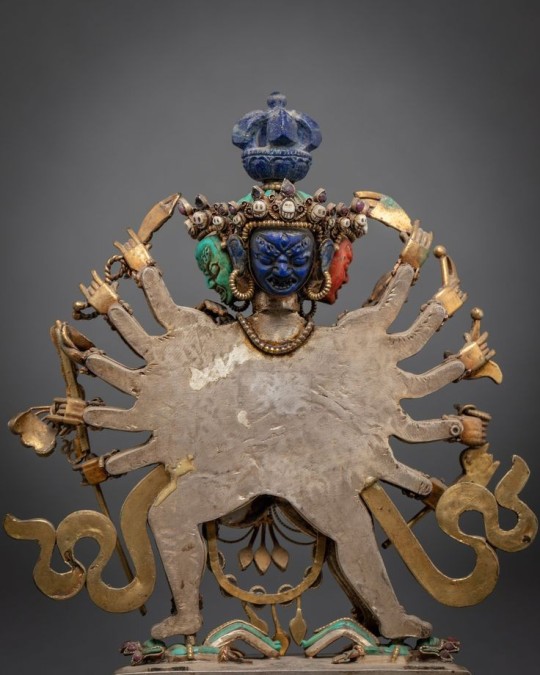
Through the blessings and kindness of the guru, great bliss, the realization of emptiness, the union of samsara and nirvana, can be obtained instantly.
~ Chakrasamvara Tantra
通過上師的加持與仁慈,可頃刻獲得大樂,証悟空性,輪涅相融。
~ 勝樂金剛續
0 notes
Photo
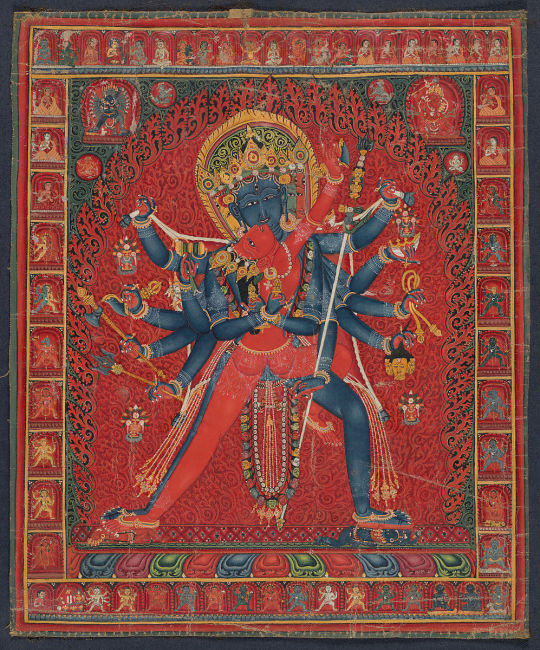
Chakrasamvara and consort Vajravarahi
Tibet, 1450–1500
12 notes
·
View notes
Text
Vajradaka June 2022.
"Vajradaka is a deity of purification and his practice originates from the Chakrasamvara Cycle of Tantras. His ritual involves the use of a brazier in the shape of the deity and several specific meditations involving purification as detailed in his practice text. At a specific point in the ritual, the practitioner inserts black sesame seeds into the mouth of the Vajradaka shaped brazier, which then fall through the body onto burning incense or coal. In the process, the seeds are burnt and turn to smoke, just as the negative karma, diseases and hindrances of the practitioner are destroyed through the visualisation and meditations of the practitioner."
Excerpt from an article: https://www.tsemrinpoche.com/tsem-tulku-rinpoche/one-minute-story/vajradaka-deity-of-purification
.
.
.
.
Watercolour on cold pressed Fabriano paper.

#artofnature#aurovilleindia#art on tumblr#artforlove#artfantasy#watercolor#travel#i am a visionary#Visionary painting#visionart#Bali#Vajradaka#art#artforthesoul#artforsale#art print#Dream#traditional art#artcollectors#contemporarygallery#myths of the realm#stories#visual novel#visualart
1 note
·
View note
Text

Yab Yum
Chakrasamvara Heruka (Father) in YabYum union with Vajrayogini (Mother) symbolizes the union of compassion and wisdom.
Photo gorgeous thangka created by magnificent artist Laura Santi
Yab Yum means Father Mother
Deities visualized in consort union are Yab Yum. Yab means literally “father” and Yum means literally “mother.” This gives a sense of the concept of YabYum as a higher emanation of Buddhas — it’s the highest of visualized practice, Highest Yoga Tantra — because it is a complete visualization combining the Enlighted Compassion and Wisdom as Father and Mother, not just one, or the other.
7 notes
·
View notes
Text
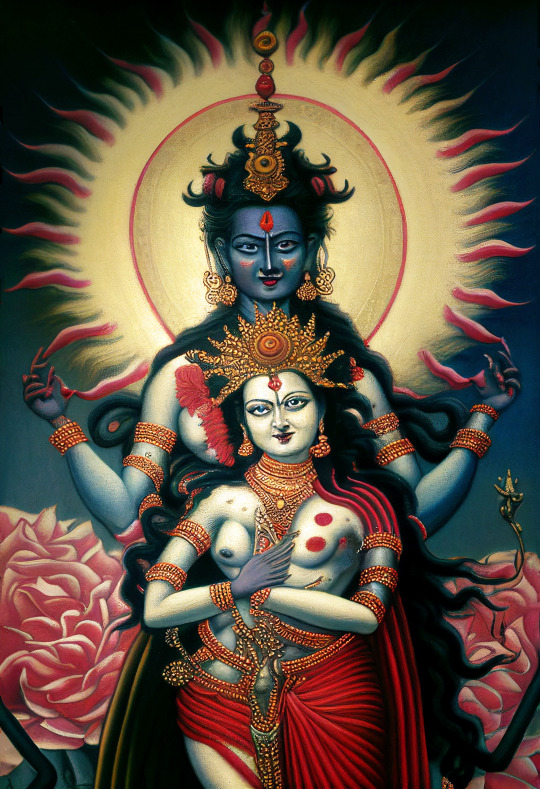
'Heruka Chakrasamvara'
Emanation of Buddha Shakyamuni
Talon Abraxas
Buddha Shakyamuni himself manifested in the form of Heruka Chakrasamvara to subdue the God Ishvara for the benefit of all beings. Therefore he is considered the source of this high tantra.
With a majestic light-body of dazzling dark blue radiance, Heruka embodies the great bliss of inner transformation, the liberation from ignorance.
By him, the polluted rivers of delusion are transformed into holy waters that run to the sea of surrender. He has four faces, twelve arms, and is in union with his consort, Vajrayogini.
The mantra of Heruka is
OM SHRI VAJRA HE HE RU RU KAM HUM HUM P'HAT DAKINI DZALA SHAMBARAM SOHA
22 notes
·
View notes
Text

Five main tantras of the Shangpa Kagyu which are all together make one unit, which is known as Gyu De Lha Nga (Five Deity Tantra) :
Hevajra,
Chakrasamvara,
Guhyasamaja,
Mahamaya, and
Yamantaka.
8 notes
·
View notes